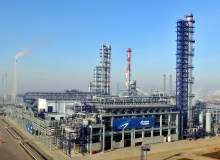
Omsk refinery is located in Omsk, Russia. Operated by Gazprom Neft, a subsidiary of Gazprom, it is one of the biggest refineries in the country. The refinery commenced operations in September 1955 with a processing capacity of three million tons per annum (mtpa) of crude oil. The current processing capacity of the refinery is 19.5mtpa.
The refinery initially processed feedstock from Bashkortostan. From 1964, the refinery started processing feedstock from oil fields in Siberia. Feedstock was delivered by tankers and later through the Ust-Balik-Omsk pipeline.
Major products of the refinery include petrol, diesel, fuel oil and jet fuel. The refinery also produces a range of aromatics, liquefied petroleum gases, lubricants, additives and catalysts.
Infrastructure of the refinery
The refinery includes a deep conversion complex, an aromatics complex, alkylation facilities, offsites, storage tanks and other facilities.
The deep conversion complex includes a vacuum distillation unit, vacuum gas oil hydroteater, fluidised catalytic converter, visbreaking unit, methyl tertiary butyl ether unit and sulphur and hydrogen production units. It became operational in 1994 enabling the refinery to process heavy oil and increase oil conversion rates to 85%.
The aromatics complex includes 11 process units – a fine fractionator, hydrotreater, platformer, extractor, paraxylene unit, xylenes isomerisation unit, aromatics transalkylation unit and toluene thermal hydrodealkylation unit.
The main process unit in the complex is the platformer featuring catalyst continuous regeneration.
The aromatics complex produces a range of aromatics at the highest purity ratings in the world – benzene (99.98% purity), paraxylene (99.95% purity) and orthoxylene (99.6% purity).
Extension / development proposals
In 2010, a new naphtha isomerisation plant called lzomalk-2 was commissioned at the plant. The 800,000tpa unit produces isomerizate with zero sulphur, aromatic and unsaturated hydrocarbons content.
It enabled the refinery to commence production of high-octane gasoline of the Euro 4 standard in March 2011 and of Euro 5 standard in July 2011.
A new unit for producing bitumen was commissioned at the refinery in October 2010. It has the capacity to produce 10,000l of polymer-bitumen binders and 3,000l of bitumen emulsions annually.
In 2011, a mid-term investment programme for the refinery was announced. The programme is aimed at producing Euro 4 gasoline and diesel by 2012 and Euro 5 products from 2015.
The main component of the $500m investment programme is the construction of a diesel hydrotreater and catalytically cracked gasoline hydrotreatment complex. The diesel fuel hydrotreater will have a capacity of 3mtpa and the catalytically cracked gasoline hydrotreater will have a capacity of 1.2mtpa.
Construction of the new units commenced in 2010 and is expected to be completed by 2012. With the completion of the new units all products of the refinery will comply with Euro 4 and 5 standards.
The programme also includes restructuring of the deep conversion and alkylation facilities which will improve the quality of the products and increase efficiency. The air / nitrogen plant will also be upgraded and a heavy petroleum products tank farm, LPG tank farm, H2S and alkali tank farm will be added.
Construction of feed storage facilities for bitumen and coke production and modification of waste water treatment facilities is also part of the programme. This will improve the health, safety and environmental standards of the refinery.
Contractors with a role in the Russian Omsk refinery
IKT Group equipped the refinery with a SAP-based corporate enterprise management system aimed at reducing power consumption and boost production volumes. The aromatics complex of the refinery was built by Technip.
Daily Thermetrics equipped the diesel fuel plant of the refinery with its CatTracker temperature measurement units.
MARCON constructed a three track automated loading station at the refinery.
Elliot Group was awarded the contract for supplying compressors for the hydrogen-recovery unit of the new diesel hydrotreatment complex. Front end engineering design (FEED) for the new diesel hydrotreater was provided by UOP. Omskneftekhimproekt provided the detailed design for the unit.
FEED for the catalytically cracked gasoline hydrotreatment complex was provided by AXENS. Detailed design was provided by Neftekhimproekt.



